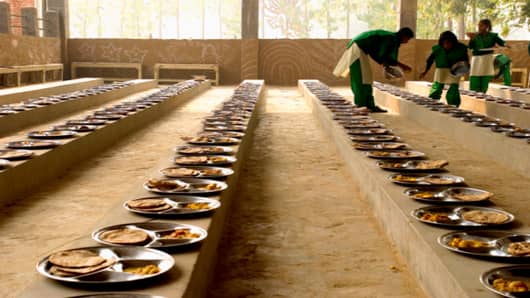The Indian government announced on Thursday it would set up an inquiry into the quality of food given to school pupils in a nationwide free meal scheme after at least 23 children died in one of the deadliest outbreaks of mass poisoning in years.
Within minutes of eating a meal of rice and potato curry in the eastern state of Bihar on Tuesday, the children began to fall ill, a cook at the school at the center of the outbreak told Reuters from her hospital bed.
The children, aged four to 12, died after vomiting and convulsing from agonizing stomach cramps, officials and relatives said. Death came so quickly for some that they died in their parents' arms while being taken to hospital.
Dozens of other children are being treated for food poisoning in hospital. Police said they were searching for the headmistress of the school in Gandaman village in Bihar, one of India's most impoverished states, who has disappeared, along with her family. The school provided free meals under the Mid-Day Meal Scheme, the world's largest school feeding program involving 120 million children.
(Read More: As mystery illness stalks its young, India intensifies search for a killer)
Police said it was not possible to conclusively say what caused the poisoning, but the focus of the investigation was on the oil used in the preparation of the meal.
Doctors treating the children said they suspected the food had been contaminated with insecticide. Media reports said the cooking oil may have been stored in an old pesticide container, but there was no independent confirmation of this.
"The minute the children were brought in, we smelled this foul odor of organophosphorus," said Dr. Vinod Mishra, a doctor in the medical team treating many of the children at Patna Medical College Hospital in Bihar's capital, Patna.
Organophosphorus compounds are used as pesticides, which are widely available and are sold under a variety of different brands.
The medical superintendent of the hospital, Dr. Amarkant Jha, said 23 of the 24 children at the hospital were recovering well and out of danger. One was still in a critical condition.
(Read More: Food supply under assault as climate heats up)
Police said witnesses had given different versions of how the children fell ill. Central to solving the mystery was finding the headmistress, who fled the village with her family soon after the mass food poisoning, they said.
"The search is on to nab her. She will be the key to the investigation because she will be the one who can share details about the quality of food and the supplier," said Sujit Kumar, superintendent of police in Saran district, where Gandaman village is located.
When Reuters visited the school, a tiny ramshackle turquoise building in the middle of the village, it still bore signs of the chaos that erupted on Tuesday. Books were strewn over the floor of the only classroom, along with scattered metal plates and schoolbags. The room had no fans, lights, chairs or desks.
Parents said ingredients for the lunches like rice, lentils, salt and oil, were stored at the headmistress's house and brought to the school each day because there was no storage space at the school. The "kitchen" is a pile of bricks and charcoal outside the classroom.
(Read More: Lack of affordable housing forces India's poor into death traps)
Local farmer Ajay Kumar's 5-year-old daughter was among the victims. He was in his house, which is about 100 meters from the school, when he heard screams from neighbors saying the children had fallen ill.
"I rushed there and all the kids were on their backs or clutching their stomachs or vomiting. I picked up my girl and took her to the local hospital right away," Ajay said.
Parents hitched rides or took public transport to get to the hospital, which is about 15 km (nine miles) from the village, he said. Medical staff told them they had no medicines to give them. His daughter died shortly afterwards, writhing in pain on the floor.
When Reuters visited the village, there were at least 18 burial mounds, many in a large field opposite the school. Some contained multiple bodies and villagers could not agree on how many children were buried in them. Many parents said they buried their children's toys and clothes in the graves.
Actions will be taken
Federal Education Minister M.M. Pallam Raju vowed that "action will be taken" against those responsible for the 23 deaths but did not single out anyone by name. He gave no details of the committee he was setting up to investigate food quality in the mid-day meal scheme.
The announcement may be met with some skepticism as the government often sets up committees to investigate issues. These often take years to produce reports, which rarely lead to any changes in policy.
With her mother sitting beside her, one of the school's cooks, Manju Devi, lay in bed in a dimly lit ward of the Patna hospital, almost too weak to talk.
Speaking in a local Bihari dialect, she told Reuters that she had almost immediately fallen ill, along with the children, after eating the lunch of rice and potatoes.
(Read More: Protesters Set Cars, Truck on Fire in India Strike)
When asked if she had prepared it, her mother quickly intervened, saying,
"No! She had nothing to do with the meal that day, another cook had made the deal that day."
Although there have been widespread complaints of food quality in the Mid-Day Meal Scheme in India, cases of mass food poisoning are rare.
In 1998, adulterated rapeseed oil killed as many as 60 people in the capital New Delhi. Investigations later revealed that the oil had been mixed with white oil, a petroleum product.


